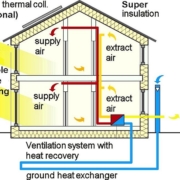Passivhaus
Passivhaus can refer to a technical standard or a philosophy for buildings that function with little or no external energy input. A Passivhaus may also be an actual building or house. The Passivhaus, or Passive House, standard stipulates very low annual energy consumption for heating and cooling, and very low levels of air leakage from the building. This standard arose from research projects in Germany in the 1980s and 1990s, bringing the German word to a wider audience via projects, buildings and the Passiv Institut in Darmstadt. The use of the term passiv may have originated from earlier use of passive solar heating, where solar heat is captured and stored in a heat sink to maintain the temperature of a house.
Passivhaus buildings involve a special design process, feature very high levels of insulation called superinsulation, and do not need a conventional full heating system. The relatively sealed nature of the building normally requires some mechanical form of air circulation, such as a heat exchanger. Different countries have been developing their own Passivhaus standards in response to their own climate circumstances, and to meet these standards a Passivhaus does not necessarily have to employ passive solar or even achieve net zero energy consumption.

 https://en.wikipedia.org/wiki/Creative_Commons
https://en.wikipedia.org/wiki/Creative_Commons https://creativecommons.org/licenses/by-sa/3.0/deed.en
https://creativecommons.org/licenses/by-sa/3.0/deed.en
